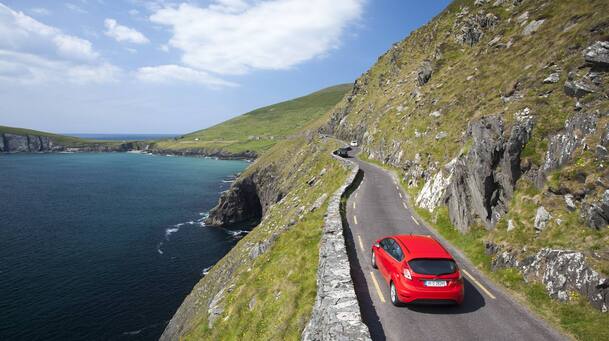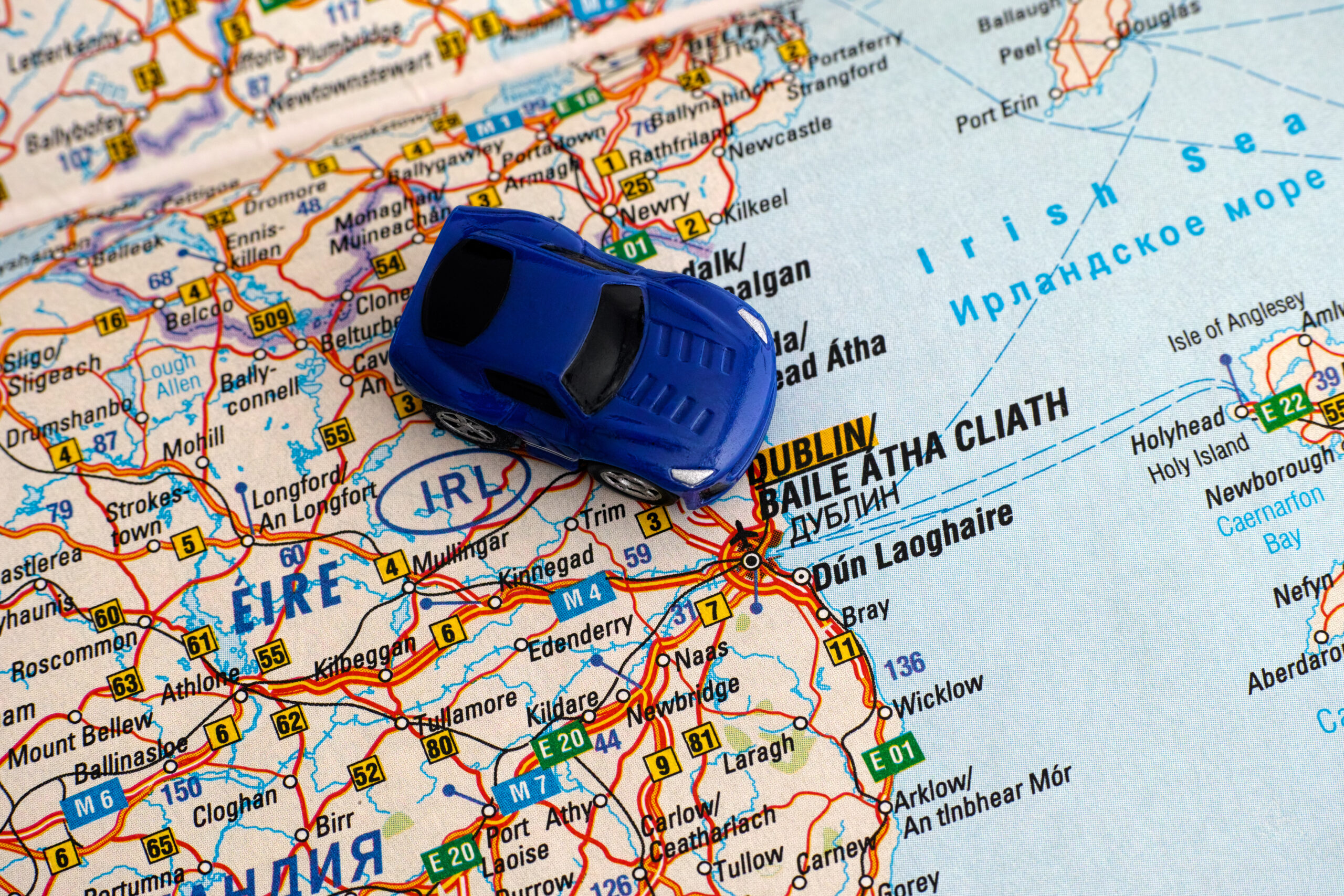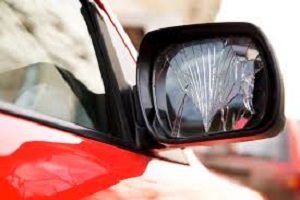Yes. Insurance for a single day is available.
Navigating the Emerald Isle: Essential Tips for Driving in Ireland
PUBLISHED ON Mar, 21 2024

Planning to navigate Ireland’s roads? Arm yourself with vital information on traffic laws, car rentals, and tolls for a stress-free journey. This essential guide outlines what you need to know when driving in Ireland, ensuring you’re well-equipped for the scenic drives and city excursions ahead.
Key Takeaways
- Drive on the left in Ireland, look out for various speed limits, and follow stringent drink-driving laws with specific alcohol limits for different drivers.
- Expect diverse road types and strict seatbelt regulations, while practicing caution with pedestrians, cyclists, and farm animals on all roads.
- Utilize essential gadgets and apps for navigation and local services, and familiarize yourself with local parking norms and fuel/charging station locations.
Navigating the Emerald Isle: Essential Tips for Driving in Ireland

Winding road in the Irish countryside
As with any adventure, your Irish road trip begins with a solid understanding of the rules of the road, both in the Republic of Ireland and Northern Ireland. If you’re a seasoned driver, you’re probably used to sharing the road with other vehicles. But are you used to sharing it with animals and farm equipment too? Welcome to the Irish country roads! Navigating these roads can be an exciting challenge, especially when you’re also grappling with left-hand driving and quirky roundabouts.
However, there’s no need to feel intimidated. Achieving safety on Irish roads is a direct process. Here are some tips to keep in mind:
- Avoid distractions such as using your phone or eating while driving
- Always be aware of pedestrians who may step onto the road from your left
- When in doubt, slow down and take your time
After all, you’re here to enjoy the beautiful country that Ireland offers, not to speed through it!
Introduction
So you’ve decided to embark on a road trip in Ireland – an excellent choice! However, just like any travel experience, preparation is key. This is especially true when it comes to driving in a foreign country. Adapting to new road rules, navigating unfamiliar terrains, and understanding local driving etiquettes are just a few things you’ll need to consider. Fear not! With some planning and accurate information, you’ll find driving in Ireland effortless. And that’s exactly what this guide is here for – to provide you with essential tips and insights to ensure a smooth and enjoyable driving experience.
Fasten your seatbelt, it’s time to begin!
Understanding Irish Road Rules
Before you turn the ignition and set off, it’s important to get acquainted with Ireland’s road rules. Knowing the rules can help you navigate the roads confidently and safely, whether you’re driving through the bustling streets of Dublin or cruising along the serene country roads of County Clare.
We’ll begin with the most basic rule – always stay to the left. This rule applies across the country, from the vibrant city roads to the winding country lanes. So, whether you’re making a left turn or passing oncoming traffic, always remember to stick to the left side of the road.
Left-Hand Driving Mastery
For those accustomed to right-hand driving, shifting to left-hand can initially be a tad perplexing. But with a few tips and a bit of practice, you can master it in no time, sometimes even in just a few days.
When driving on the left hand side, always remember that the driver should be closest to the center of the road. This can help you maintain proper lane discipline and avoid straying into oncoming traffic. Also, consider hiring an automatic car. This can make the transition to left-hand driving easier by eliminating the challenge of manual gear shifts.
Remember, it’s normal to make mistakes when learning something new. The key is to stay calm, make necessary adjustments, and keep practicing. Before you know it, you’ll be driving on the left like a local!
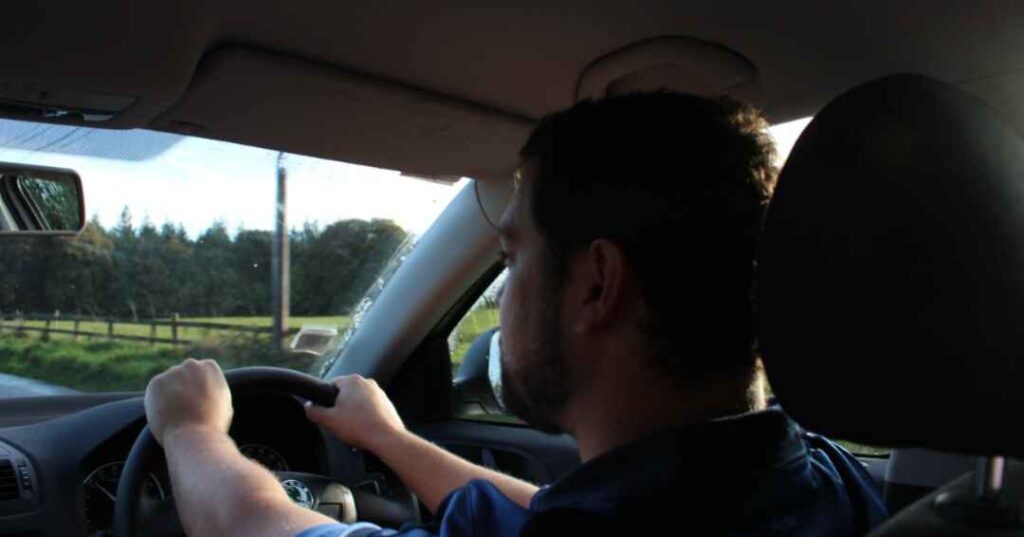
Driving on the left side in Ireland
Speed Limits Explained
Similar to other countries, Ireland enforces speed limits for the sake of road safety. But unlike many countries, the speed limits in Ireland vary depending on the type of road. Here are the speed limits in Ireland:
- Motorways: 120 km/h
- National roads: 100 km/h
- Regional roads: 80 km/h
- Urban areas: 50 km/h
- Special limits, such as 30 km/h near schools
If you’re towing a caravan or trailer, the maximum speed limit is 80 km/h. Remember, these are maximum limits, not targets. Always drive at a speed that’s safe for the road conditions, and be prepared to slow down if necessary.
Drink Driving Regulations
Ireland enforces stringent drink-driving regulations to maintain road safety. The legal blood alcohol limit for fully licensed drivers is 50 milligrammes per 100ml of blood. For learner, novice, and professional drivers, the limit is even lower, at 20 milligrammes per 100ml of blood. To enforce these regulations, the local police force operates random breath-test checkpoints throughout the country.
So, if you’re planning to enjoy a pint of Guinness, make sure you have a designated driver or take a taxi. Remember, the safest amount of alcohol when driving is none at all.
The Driver’s Guide to Irish Roads
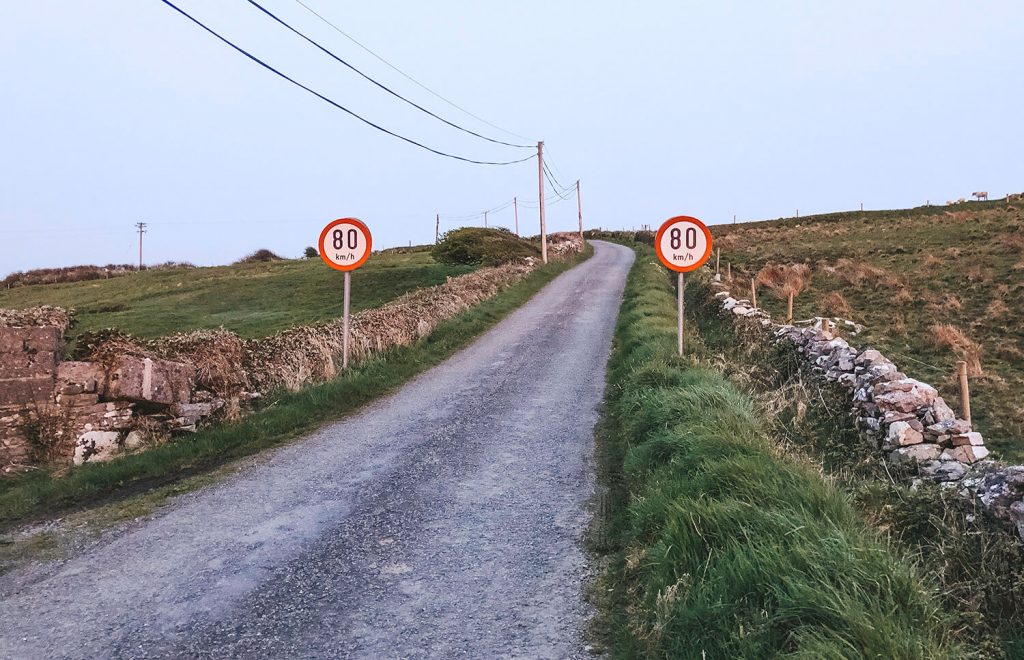
Rural road in Ireland
Having covered the road rules, it’s time to examine the roads themselves more closely. Irish roads are as diverse as the country’s landscape, ranging from narrow rural lanes to modern motorways. As you drive through Ireland, you’ll encounter a variety of road types, each offering its unique driving experience.
But whether you’re cruising along the scenic Wild Atlantic Way or navigating through the bustling streets of Dublin, there are a few things to keep in mind. Always drive cautiously and at reduced speeds on narrow country lanes, and be prepared for potential potholes and unexpected bends. And remember, even the smallest side roads are shared with other road users, including cyclists, pedestrians, and even farm animals, so always stay alert and give way when necessary.
From Rural Routes to National Roads
The diversity of Ireland’s road network mirrors its landscapes, with different types of roads serving different purposes:
- Motorways: These link major cities and provide fast, efficient travel. They are marked with an “M” followed by a number.
- National primary roads: These are important cross-country routes and include all motorways. They are marked with an “N” followed by a number.
- National secondary roads: These connect large towns that are not covered by primary routes. They are marked with an “N” followed by a number.
- Regional roads: These connect small towns and provide access to the main national road network. They are marked with an “R” followed by a number.
- Local roads: These can include wide urban streets and narrow rural lanes, and they further connect the different road networks.
While driving on these rural roads, be prepared for potential obstructions like tractors and livestock, and always signal your intentions clearly to other road users. Remember, the key to a smooth journey is patience and respect for other road users.
Signposts and Street Signs
While driving in Ireland, it’s crucial to get acquainted with the local road signs and understand language discrepancies. Here are some important things to know:
- Road signs in the Republic of Ireland are typically bilingual, displaying both Irish and English.
- In Gaeltacht areas, signs are exclusively in Irish.
- In Northern Ireland, signs are in English only.
Also, the Republic of Ireland uses kilometers for distance measurements, while Northern Ireland uses miles. So, whether you’re driving along a scenic route in the Republic of Ireland or navigating the city streets of Belfast, make sure you understand the signs and measurements. And remember, when in doubt, it’s always best to ask a local or refer to your GPS or map.
Car Rental Insights
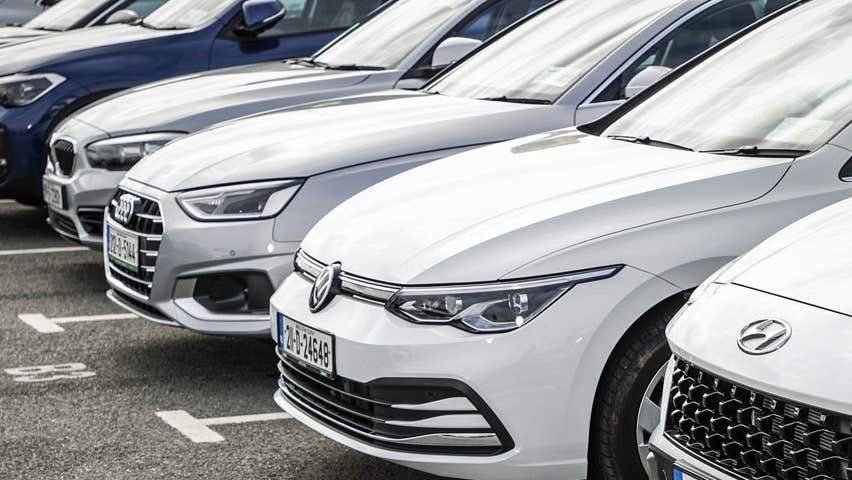
Rental car in a parking lot
Selecting the appropriate rental car for your Irish journey can significantly enhance your driving experience. Most rental cars in Ireland come with a manual transmission, which can be a challenge if you’re used to an automatic. However, automatic cars are available for rent, albeit at a higher cost.
When choosing a car, consider the following factors:
- The size of your travel party and the level of comfort needed for longer drives
- The type of roads you’ll be driving on. For example, a compact car might be ideal for city driving, but a slightly larger vehicle may be more suitable for rugged rural terrains
- Always double-check whether your preferred car takes petrol or diesel to avoid fuel contamination issues.
Choosing the Right Vehicle
Choosing an appropriate vehicle is key to a successful road trip. Here are some factors to consider:
- If you’re not comfortable with a manual transmission, make sure to book an automatic car well in advance.
- Size matters. A smaller car might be easier to navigate and park, especially on narrow and winding country roads. But if you’re planning to cover long distances or if you’re traveling with a larger group, you might want to consider a larger vehicle for a more comfortable ride.
- Don’t forget to consider fuel efficiency, especially if you’re planning a longer road trip.
Insurance and Legal Requirements
Prior to setting off, it’s crucial to comprehend the insurance and legal requirements for driving in Ireland. Tourists from certain countries, including the United States, can drive in Ireland with their valid national driving licence for up to 12 months without needing an International Driving Permit (IDP). However, for stays over 12 months, or for additional verification, it’s recommended to obtain an IDP.
When renting a car from a car rental company, you’ll need to provide a valid credit card, as debit cards, cash, or checks are generally not accepted. Also, be sure to check your car rental agreement carefully to understand what is included in your rental rate and what additional charges or liabilities might apply.
Car rental insurance provides financial protection and peace of mind in case of accidents, damage, or theft during your rental period. Before embarking on your Irish adventure, it’s essential to understand the ins and outs of car rental insurance for Ireland.
See How Much You Can Save on Your Rental Car Insurance for Ireland
Get StartedPreparing for the Drive
Driving in a foreign country can seem daunting, particularly if you’re unacquainted with the local road rules and driving conditions. But with a bit of preparation, you can hit the road with confidence and ease. Before you start driving, take a few minutes to familiarize yourself with your hire car. Adjust the mirrors, check the controls, and make sure you understand how to operate key functions such as wipers, defroster, lights, and shifter.
Once you’re comfortable with the car, start with a short and simple route to gain confidence. And remember, practice makes perfect. The more you drive, the more comfortable you’ll become.
Familiarizing Yourself with Your Hire Car
Once you’ve picked up your car, it’s important to spend a few minutes getting to know the vehicle before you start driving. It’s important to understand how to operate key functions such as:
- the wipers
- the defroster
- the lights
- the shifter
- the mirrors
Take the time to familiarize yourself with these functions before driving a manual transmission vehicle. Renting an automatic transmission car can ease the transition to left-hand driving and sitting on the right side of the car.
Remember to adjust the rearview mirror to the left rather than the right to ensure you have a proper view of traffic behind you in Ireland. And don’t forget to conduct a detailed inspection of the vehicle for any existing damage, taking photos for documentation.
Practice Makes Perfect
Like any other skill, mastering driving in Ireland requires practice. To acclimatize to the local driving conditions, consider starting your driving experience in a parking lot to gain confidence. You can also take a driving lesson to assist in adapting to left-hand driving.
And if you’re apprehensive about navigating busy roundabouts, practice in quieter areas to become more comfortable. Remember, every driver was once a beginner. With a bit of practice and patience, you’ll soon be navigating the Irish roads like a pro!
Toll Road Navigation
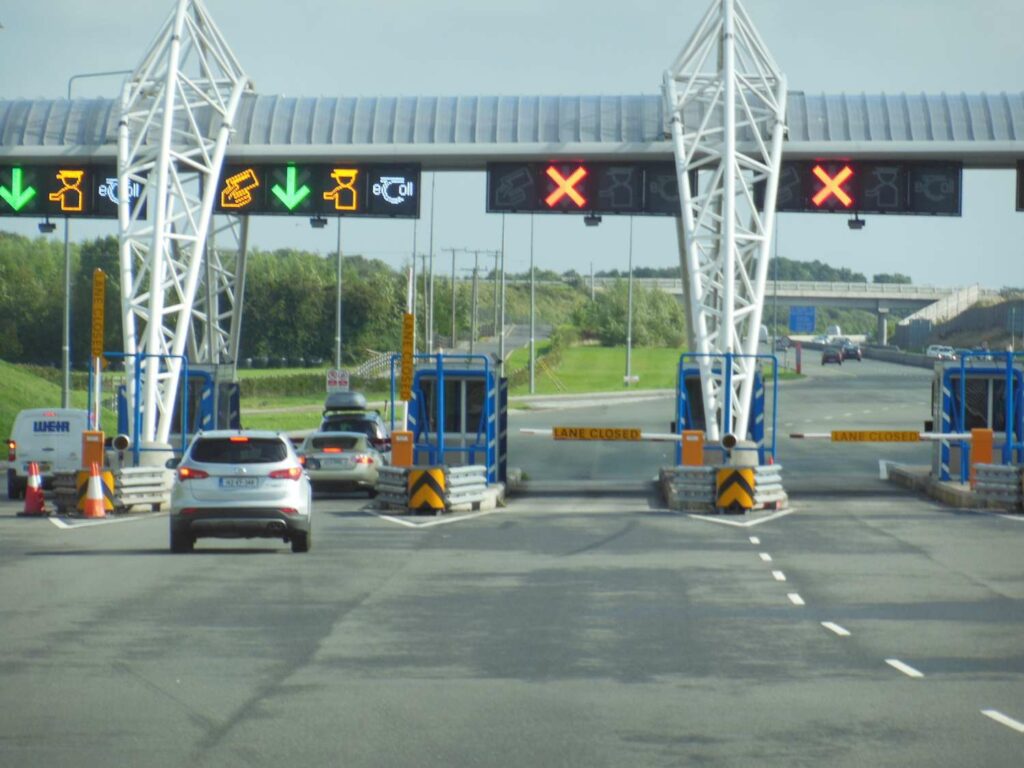
Toll booth on a road in Ireland
You might find driving on Ireland’s toll roads slightly different from your usual experience. The M50 eFlow Barrier System uses RFID tagging for toll collection and is managed by Turas Mobility Services on behalf of Transport Infrastructure Ireland. Introduced on August 30, 2008, the eFlow’s electronic tolling system on the M50 employs overhead cameras and detectors to read electronic tags or number plates, allowing for barrier-free and cashless payment.
eFlow tags are compatible with other eToll plazas on Ireland’s road network, and electronic tags from other providers can also be used on the M50.
Identifying Toll Routes
Toll roads in Ireland can be identified as major routes that connect key cities and regions. Major toll routes in Ireland include:
- M7/M8 Portlaoise to Cullahill
- N8 Rathcormac to Fermoy Bypass
- N25 Waterford City Bypass
- Limerick Tunnel
- M6 Galway to Ballinasloe
- M4 Kilcock to Kinnegad Motorway
- M3 Clonee to Kells
- M1 Motorway
- East Link Toll Bridge
- Dublin Port Tunnel
The M50 operates a unique barrier-free tolling system called eFlow, which does not require vehicles to stop and allows them to pass at motorway speeds.
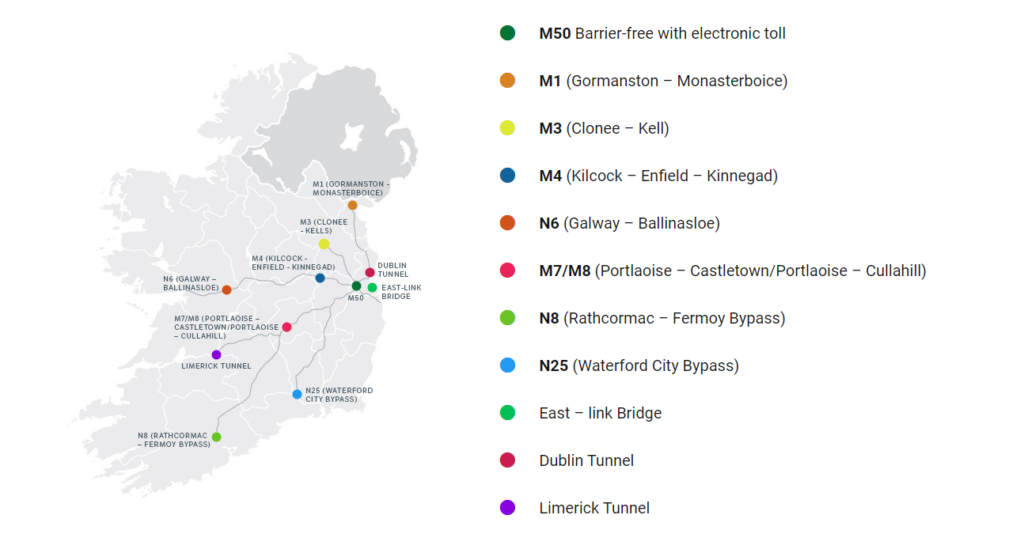
Irish Toll Roads Map
Payment Options for Tolls
When it comes to paying for tolls, Ireland offers several options:
- The M50 eFlow barrier-free toll system captures vehicle license plates automatically and requires payment by the next evening at 8 pm. Unregistered vehicles are charged rates ranging from €3.10 for cars to €6.40 for heavy goods vehicles on the M50 eFlow toll.
- Toll payments across Ireland can also be made using cash at toll barriers.
- Another option is the eToll tag system.
Using a toll tag device allows for access to fast lanes at toll barriers and prevents the need for manual payment of each toll. For M50 toll payment, options include online payment, calling a specified number, or visiting Payzone outlets.
Safety First: Seat Belts and Child Seats
In Ireland, safety is the top priority. This extends to road safety, where wearing a seat belt is non-negotiable. Every individual in a vehicle must wear a seat belt if one is available, and this rule applies to both front and rear seat occupants. Drivers are legally responsible for ensuring that all passengers under the age of 17 are using seat belts while in the car.
For child safety during travel, the appropriate use of a child restraint system is crucial as it significantly reduces the risk of injury in case of an accident. Whether you’re driving in a bustling city or a quiet country lane, always remember – seat belts save lives.
Seat Belt Compliance
In Ireland, drivers and passengers are legally required to wear seat belts if they are fitted in the vehicle. The driver is responsible for ensuring that all passengers under 17 are suitably restrained. There are some exemptions to the seat belt law, but they do not specify children, emphasizing the critical importance of securing them properly in vehicles.
Seat belts are recognized as a critical life-saving device and must be used on every journey in a vehicle, no matter how short the distance may be. Remember, in the event of a collision, an unrestrained passenger can be thrown forward with a force of 30 to 60 times their own body weight, potentially leading to fatal consequences. So, always buckle up!
Securing Young Passengers
When it comes to the safety of young passengers, Ireland has specific regulations in place. All children under 150 cm in height or who weigh less than 36 kg (79 lbs) must use child restraint systems (CRS). These include child car seats and booster cushions.
Using a rearward-facing child car seat in the front seat where there is an active airbag is illegal. Children can sit in the front seat but must use the correct restraint based on their height and weight. The RSA provides a ‘Check it Fits’ service to ensure child car seats are compatible with the vehicle and properly fitted.
Remember, your little ones count on you to keep them safe, so always make sure they are properly secured in your vehicle.
Conquering Irish Roundabouts and Intersections
Navigating roundabouts and intersections might seem challenging, particularly for those new to driving in Ireland. But once you understand the rules, you’ll find that they’re actually quite straightforward. In Ireland, the rule of the road is that traffic approaching from the right has the right of way at crossroads or roundabouts, unless otherwise indicated by road signage. So, whether you’re navigating a bustling city intersection or a quiet rural roundabout, always look to your right and yield to oncoming traffic.
And remember, practice makes perfect! The more you drive, the more comfortable you’ll become with these unique driving scenarios.
Mastering Roundabouts
Roundabouts are a common feature of Irish roads, and mastering them is key to a smooth driving experience. When approaching a roundabout, yield to both the traffic already on the roundabout and to traffic approaching from your right. Use the left lane when taking the first exit off the roundabout, going straight ahead, or when no signage is present.
If you miss your exit, keep signaling right to go around again and then signal left after passing the exit before yours. Approach roundabouts carefully and slowly, and be especially patient during peak times. With a bit of practice, you’ll soon be navigating roundabouts like a pro!
Navigating Intersections
Intersections in Ireland can be a bit tricky, especially if you’re new to driving on the left. But once you understand the rules, they’re actually quite straightforward. At unmarked crossings, the vehicle coming from the right has the right of way. Marked intersections use yellow signs with black markings to indicate right of way, with thicker lines showing the paths that have priority.
If traffic lights are present, give priority to the signals and ensure safety before proceeding on a green light. And remember, if you miss your turn or are in the wrong lane, don’t panic. Simply go around the block and try again.
Essential Gadgets and Apps for Your Road Trip
In the current digital era, a myriad of gadgets and apps exist that can enhance the enjoyment of your road trip and reduce stress. Some essential gadgets and apps for your road trip include:
- A reliable smartphone or GPS device for navigating through diverse landscapes
- Recommended navigation apps like Google Maps for real-time traffic updates and diverse route options
- A dedicated GPS unit like Garmin or TomTom, particularly in areas with poor mobile reception
These gadgets and apps will help ensure a smooth and enjoyable road trip experience.
And don’t forget about apps like GasBuddy and Parkopedia, which can help you find nearby gas stations and parking spots. So, before you hit the road, make sure your digital toolkit is well-equipped!
Navigation Tools
When it comes to navigating the Irish roads, a reliable GPS device or navigation app can be your best friend. Garmin GPS devices are widely used in Ireland due to their precise mapping of the country. The Garmin Nuvi series is recommended, especially models with the ‘LM’ suffix that offer lifetime map updates. For smartphone users, the TomTom GO Navigation app offers reliable offline maps and real-time traffic updates.
And if you’re planning to avoid toll roads, your GPS device can help you plan your routes accordingly. So, whether you’re heading to a major city or a hidden gem in the countryside, trust your navigation tools to guide you there!
Helpful Apps
In addition to navigation tools, there are several other apps that can enhance your driving experience in Ireland. Here are some recommendations:
- Waze: for real-time traffic updates and alerts
- Open Table: to make restaurant reservations
- Just Eat, Deliveroo, and Uber Eats: for food delivery services
These apps can help you navigate the roads and explore the local food scene in Ireland.
So, before you hit the road, make sure to download these helpful apps to your mobile device. They’ll make your road trip more convenient, enjoyable, and delicious!
Fuel and Charging Stations

Gas station with charging stations for electric vehicles
Maintaining a well-fueled vehicle is a must for any road trip, and in Ireland, you’re spoilt for choice. The main brands of petrol stations in the country include:
- Circle K
- Texaco
- Shell
- Esso
- Applegreen
But what if you’re driving an electric vehicle (EV)? No problem! The ESB eCars network provides an online map to locate electric car charging points across Ireland. From standard chargers to fast chargers and high power EV charging hubs, you’ll find plenty of options to keep your EV juiced up and ready to go.
So, whether you’re driving a petrol, diesel, or electric vehicle, you’ll never be far from a refuelling or charging station in Ireland.
Parking Made Easy
Securing a parking spot might prove challenging, particularly in bustling city centers. But with a bit of knowledge and planning, parking in Ireland can be a breeze. In cities like Dublin, Cork, and Limerick, parking might involve both metered spaces and dedicated parking lots. It’s important to read the signs carefully to understand the time limits and payment requirements. And remember, parking enforcement is strict in Ireland, and penalties for parking violations can include fines and vehicle clamping.
So, whether you’re planning to spend a day exploring a city or just stopping by for a quick visit, make sure you know where to park.
City Parking Solutions
Parking in busy city centers can be a bit of a challenge. To manage parking in these areas, consider using public transportation or the ParkMagic app, which is available in cities like Cork, Limerick, and even near Dublin Airport.
When parking on the street, make sure to adhere strictly to the parking rules set out by the Road Traffic Acts. Look for designated spots and avoid double parking to prevent fines or having your car clamped. In cities, use parking discs for extended stays. These can be obtained from shops and displayed on dashboards with the time scratched off.
Remember, parking enforcement typically operates between 9 am-5 pm, excluding Sundays, and most parking machines only accept coin payments. So, always have some change handy!
Rural Parking Etiquette
Parking in rural areas can seem a bit informal, with cars parked on sidewalks or in various spots. However, it’s crucial to avoid blocking traffic or creating safety issues. On narrow country lanes, use ‘passing places’ to allow oncoming traffic to pass. These are usually marked by white road signs and are common in rural areas.
If you’re unsure about where to park, ask locals or your hosts for advice. They’ll be more than happy to help you navigate the local parking etiquette.
Summary
And there you have it – a comprehensive guide to driving in Ireland! From mastering left-hand driving and understanding road signs to choosing the right vehicle and navigating roundabouts, we’ve covered everything you need to know for a successful road trip in the Emerald Isle. But remember, the key to a smooth and enjoyable driving experience is preparation. So, take the time to familiarize yourself with the road rules, plan your routes carefully, and always stay alert on the road. After all, driving in Ireland is not just about getting from point A to point B – it’s about enjoying the journey and soaking in the stunning landscapes along the way. So, buckle up, start your engine, and embark on an unforgettable Irish road trip!
Frequently Asked Questions
Is it difficult for Americans to drive in Ireland?
Yes, driving in Ireland can be difficult for Americans, but with proper preparation and guidance, it can be manageable. Don’t forget to do your research beforehand to feel confident and capable on the road.
Can I drive in Ireland with US driver’s license?
Yes, you can drive in Ireland with your US driver’s license for up to 12 months as a tourist. There is no need for an International Driving Permit.
Is driving in Ireland the same as the US?
No, driving in Ireland is not the same as in the US. In Ireland, people drive on the left side of the road, and outside of major towns, most roads are two-lane or even narrower. So, it’s quite different from driving in the US.
Is Ireland left or right hand drive?
In Ireland, cars drive on the left-hand side of the road. It’s important to keep this in mind and pay extra attention when driving in a new country.
What are the speed limits in Ireland?
In Ireland, the speed limits are 120 km/h on motorways, 100 km/h on national roads, 80 km/h on regional roads, and 50 km/h in urban areas, with special limits like 30 km/h near schools. So, always be aware of the road type and adjust your speed accordingly.
Frequently Asked Questions (FAQ)
No. We provide a single journey plan. You are covered from the time you pick up the rental car up to the time you return it or on the last date written on your Certificate of Insurance, whichever comes first.
No. You should purchase a policy before starting your travel.
Find the answers you’re looking for to the most frequently asked car hire insurance questions as well as other questions relating to our products and services.
